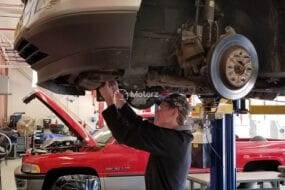Spongy Brake Pedal Explain Causes And Brake Bleeding is a common concern among car owners that can compromise the safety and performance of a vehicle. This issue is often attributed to air in the brake system, affecting the hydraulic pressure necessary for effective braking. In this article, we will explore the various causes of a spongy brake pedal and delve into the importance of brake bleeding as a solution.
Air in the Brake Lines:
Spongy Brake Pedal One of the primary reasons for a spongy brake pedal is the presence of air bubbles in the brake lines. Air can enter the system during brake component replacement, routine maintenance, or due to a brake fluid leak. Contaminated brake fluid, often caused by moisture absorption, can lead to a spongy brake pedal. Brake fluid is hygroscopic, meaning it absorbs moisture over time. Contaminated fluid reduces the brake fluid’s effectiveness and can cause corrosion within the brake system.
Brake Fluid Leak:
A leak in the brake system can result in a loss of hydraulic pressure, leading to a spongy pedal. Leaks can occur in various components, including brake lines, calipers, wheel cylinders, or the master cylinder. Identifying and fixing the source of the leak is crucial for restoring optimal brake performance.
Worn Brake Components:
Over time, brake components such as brake pads, rotors, and calipers can wear out. Worn-out components may lead to an uneven distribution of hydraulic pressure, causing a spongy brake pedal. Regular inspection and timely replacement of worn parts are essential for maintaining brake system integrity.
Purpose of Brake Bleeding:
Brake bleeding is a maintenance procedure designed to remove air bubbles from the brake system. It involves the removal of old brake fluid and air from the brake lines, replacing it with fresh, uncontaminated fluid. Brake bleeding is crucial for restoring proper hydraulic pressure and ensuring a firm brake pedal feel.
Types of Brake Bleeding:
There are different methods of brake bleeding, including the traditional pedal pumping method, pressure bleeding, and vacuum bleeding. Each method has its advantages and is chosen based on the specific requirements of the vehicle and the preferences of the technician.
DIY vs. Professional Brake Bleeding:
While some car owners may attempt to bleed their brakes at home, it is a procedure that requires precision and knowledge. Professional technicians often use specialized equipment and follow manufacturer-recommended procedures to ensure thorough brake system maintenance. DIY attempts should be approached with caution, and it’s essential to follow the vehicle’s service manual.
Preventive Brake Maintenance:
To prevent spongy brake pedals and maintain optimal brake performance, regular brake system inspections and fluid replacements are crucial. Following the manufacturer’s recommended maintenance schedule helps identify potential issues early on, reducing the risk of brake system problems.
Conclusion:
In conclusion, a spongy Spongy Brake Pedal is a symptom of underlying issues within the brake system. Understanding the causes, such as air in the brake lines, fluid contamination, leaks, and worn components, is essential for effective diagnosis and resolution. Brake bleeding emerges as a key solution, playing a vital role in maintaining the integrity of the brake system and ensuring the safety of the vehicle and its occupants. Regular brake maintenance, adherence to manufacturer recommendations, and professional assistance when needed are fundamental aspects of keeping the brake system in optimal condition.





